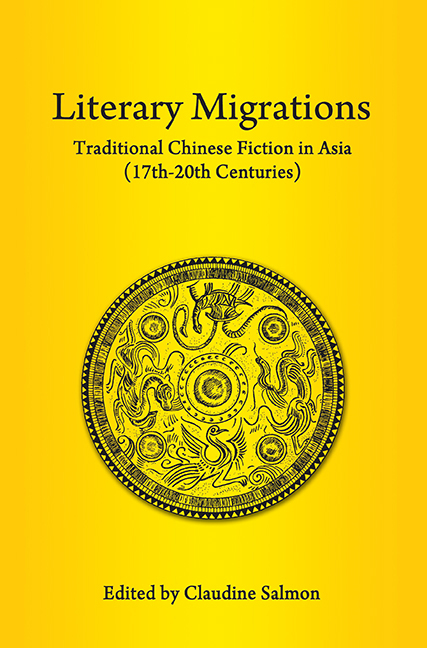Book contents
- Frontmatter
- Contents
- FOREWORD
- Dr Salmon as I Know her
- Preface to Reprint Edition
- Acknowledgements
- INTRODUCTION
- PART I KOREA AND JAPAN
- PART II MAINLAND NORTHEAST ASIA
- 4 The Manchu Translations of Chinese Novels and Short Stories — An Attempt at an Inventory
- 5 A Note about the Spread of Chinese Literature amongst the Mongols
- 6 Mongolian Translations of Old Chinese Novels and Stories — A Tentative Bibliographic Survey
- PART III MAINLAND SOUTHEAST ASIA
- PART IV INSULAR SOUTHEAST ASIA
- Bibliography
- Author, story-teller and translator index
- Title index
- List of Plates
- Contributors
- Plate section
5 - A Note about the Spread of Chinese Literature amongst the Mongols
from PART II - MAINLAND NORTHEAST ASIA
Published online by Cambridge University Press: 21 October 2015
- Frontmatter
- Contents
- FOREWORD
- Dr Salmon as I Know her
- Preface to Reprint Edition
- Acknowledgements
- INTRODUCTION
- PART I KOREA AND JAPAN
- PART II MAINLAND NORTHEAST ASIA
- 4 The Manchu Translations of Chinese Novels and Short Stories — An Attempt at an Inventory
- 5 A Note about the Spread of Chinese Literature amongst the Mongols
- 6 Mongolian Translations of Old Chinese Novels and Stories — A Tentative Bibliographic Survey
- PART III MAINLAND SOUTHEAST ASIA
- PART IV INSULAR SOUTHEAST ASIA
- Bibliography
- Author, story-teller and translator index
- Title index
- List of Plates
- Contributors
- Plate section
Summary
The diffusion of Chinese literature amongst the Mongols took place in two stages. The first of these goes back to the fourteenth century, when the Yuan rulers had the Chinese Classics translated into Mongolian for the edification of their subjects. While the Four Books (Daxue, Zhongyong, Lunyu, Mengzi)were still being reprinted in the 1920s by Temgetü (on whom see below), it was the “Classic of Filial Piety” — Xiaojing — which really took root. Already translated into Xianbi (or Sienpi)for the benefit of Tabgač youth toward the end of the fifth or the beginning of the sixth century, it was later also popular among the Tangut XiXia (or Si-Hia)and the Mongols. Thus it inspired both written and oral Mongolian aphoristic literature and has left traces throughout the entire body of Mongolian popular literature.
The second stage, that of the influence of Chinese novels, only goes back at the earliest to the seventeenth century, when the Mongols surrendered to the Manchus. And its development is closely linked to the expansion of the Qing rule in the Southern steppes from the eighteenth to the twentieth century. It is, therefore, an inherently Inner Mongolian phenomenon, which was transmitted to other regions, especially to Urga (now Ulan-Bator), mainly by Southern Mongolian emigrants. Mongolian studies have only recently discovered the enormous variety of themes and styles in this type of literature.
The first novel to be taken up by the Mongols was the Xiyou ji, “The Journey to the West”, which was then considered to be a Buddhis work. Afterwards, translated literature grew away from the monasteries, but it was not until the publication of books was no longer a monopoly of the monasteries or of governmental offices that it started to be printed. Chinese prose novels and works of fiction gave rise to two theoretically different, but in fact related styles of Mongolian literature. On the one hand, there are the more or less freely translated Chinese novels, circulated in written versions (printed belatedly).
These translated novels have given rise, since the nineteenth century, to new novels of manners, put by their Mongolian author into an imaginary Chinese surrounding, so that they would look like a translation from the Chinese.
- Type
- Chapter
- Information
- Literary MigrationsTraditional Chinese Fiction in Asia (17th–20th Centuries), pp. 127 - 129Publisher: ISEAS–Yusof Ishak InstitutePrint publication year: 2013

